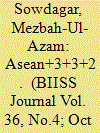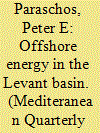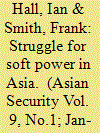|
|
|
Sort Order |
|
|
|
Items / Page
|
|
|
|
|
|
|
| Srl | Item |
| 1 |
ID:
148558


|
|
|
|
|
| Summary/Abstract |
The recent trends of regionalism in the Asia-Pacific region in perspective of the ASEAN+3+3 (Association of South East Asian Nations+China, Japan and Korea+Australia, New Zealand and India), officially known as the East Asia Summit (EAS), are important for international relations. Especially, China’s growing role and influence in this ASEAN centric new international order have attracted scholars of international relations substantially. China responded to the structural changes in East Asia, managed to transform its policies for the region in the mid-1990s and began to engage more actively than before in multilateral frameworks. The involvement of United States (US) in the regionalism has furthered a new political and strategic facet. Particularly, with this engagement, the US has made a big policy shift in the region. Taking into account of this policy shift of the two great powers, US and China, the paper mainly addresses two specific questions. First, what are the invisible dynamics of EAS politics after the US involvement? Second, how are the inside rudiments of security, political and strategic connotation in this regionalism after the US engagement? The paper aims to explain significance of recent trends of EAS centric regional competition and a deeper understanding of the increasing security, political and strategic nuances of the Asia- Pacific regionalism. The paper argues that ASEAN is inviting both powers to compete with each other through its balancing role. In the name of regional grouping, a regional security competition has been started under the umbrella of EAS.
|
|
|
|
|
|
|
|
|
|
|
|
|
|
|
|
| 2 |
ID:
159578


|
|
|
|
|
| Summary/Abstract |
Why do minor powers ever resist the demands of major powers? Although recent work has begun to provide answers to this question, we argue that research has missed a vital piece of bargaining dynamics in dyadic research: third-party influence. Using spatial modeling techniques with the Militarized Interstate Dispute and International Crisis Behavior datasets, we improve upon previous models of asymmetric conflict by showing that the presence of a neighboring rival of a minor power, and the relationship that rival has with a major power, conditions the likelihood that weak actors choose to fight the strong. The recent examples of Pakistan and Iraq, after the 9/11 terrorist attacks in the United States, serve as ideal types in which minor powers are respectively less and more likely to resist the demands of major powers. We find quantitative support that regional rivalries can act as both constrainers and enablers for minor powers when bargaining with major powers.
|
|
|
|
|
|
|
|
|
|
|
|
|
|
|
|
| 3 |
ID:
103918


|
|
|
|
|
| Publication |
2011.
|
| Summary/Abstract |
China operated an urbanization policy by which counties could be given city status between 1983 and 1997. The policy had substantial impacts on the new administrative entities, including more discretionary power and fiscal independence. Such "county-to-city upgrading" provided the central government with an instrument to reward localities. Using a large dataset covering all counties during 1993-1997, I show that upgrading is not an automatic procedure that endorses the high urbanization levels in existing counties. Although official guidelines for upgrading counties to cities were published, these requirements were largely ignored in practice. Instead, economic growth rate was the key factor in determining which counties obtained city status. This paper interprets the creation of county-level cities through upgrading as part of the incentive structure of Chinese local officials. The importance of both fiscal and political incentives facing the local government in promoting economic growth is highlighted.
|
|
|
|
|
|
|
|
|
|
|
|
|
|
|
|
| 4 |
ID:
120899


|
|
|
|
|
| Publication |
2013.
|
| Summary/Abstract |
With Israel and Cyprus recently confirming massive offshore gas reserves in the Levant Basin, the eastern Mediterranean Sea region is emerging as a significant new source of natural gas. The major economic and geopolitical implications explored in this essay include the accelerating regional competition to develop offshore energy resources; the related pursuit of major foreign investment for upstream energy development; consequences for regional gas export markets, notably the European Union; the influence of regional rivalries and conflicts on regional energy development; and the impact of the new energy resources on the regional balance of power.
|
|
|
|
|
|
|
|
|
|
|
|
|
|
|
|
| 5 |
ID:
167816


|
|
|
|
|
| Summary/Abstract |
This study examines regional competition in China by considering the spatial correlation and spillover effect of construction land price distortion using a two‐regime Spatial Durbin Model to investigate the patterns and trends of the competition between 285 cities in China from 2006 to 2015. The study finds: (i) price distortion of construction land is a common phenomenon but the distortion index generally shows a declining trend; (ii) regional competition through construction land price distortion shows a weakly intensified pattern, although the competition patterns in the four regions of China varied; and (iii) the intensity of competition between regions was lower during the 12th Five‐year Plan compared to the 11th Plan. The intensity of competition between cities was also lower inside than outside urban agglomerations. These results provide policy implications for remedying the price distortion of construction land and promoting regional coordinated development.
|
|
|
|
|
|
|
|
|
|
|
|
|
|
|
|
| 6 |
ID:
119112


|
|
|
|
|
| Publication |
2013.
|
| Summary/Abstract |
Throughout Asia, states are competing to build and leverage soft power using public diplomacy. This article examines these investments, whether they pay dividends, and why they are being made. A mix of qualitative and quantitative analysis shows little, if any, positive correlation between public diplomacy by Asian states and foreign public opinion. We therefore ask why states invest in public diplomacy when it does not seem to work. We argue that different motives are at play: The struggle for soft power is driven by both a logic of consequences and logic of appropriateness. Lastly, we suggest how this struggle might aggravate rather than ameliorate tensions in the region.
|
|
|
|
|
|
|
|
|
|
|
|
|
|
|
|
|
|
|
|
|